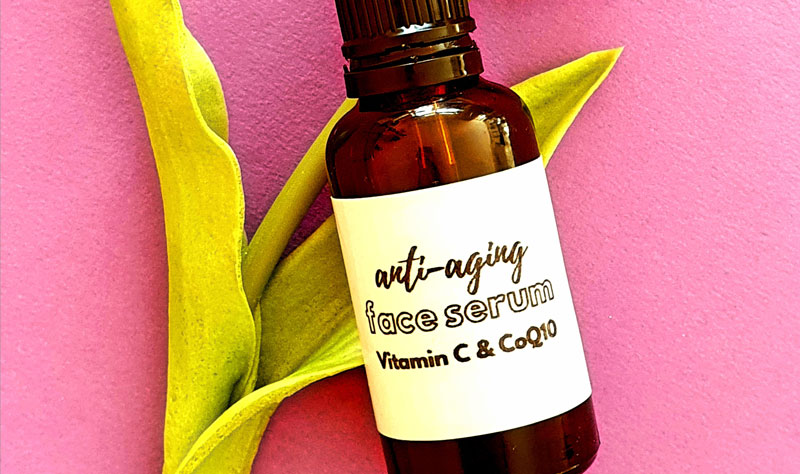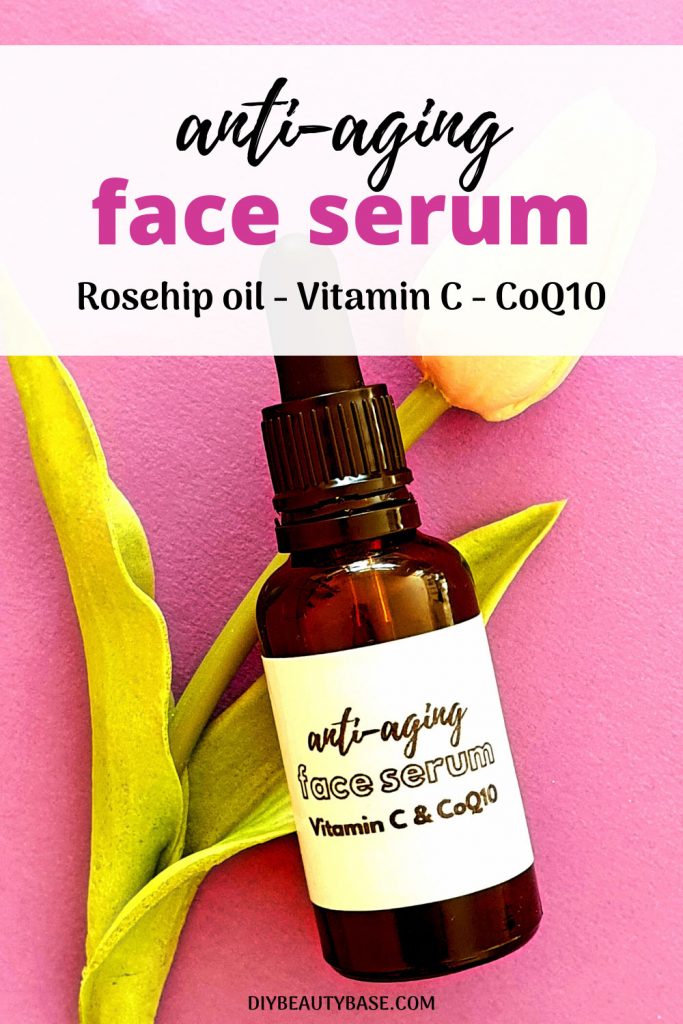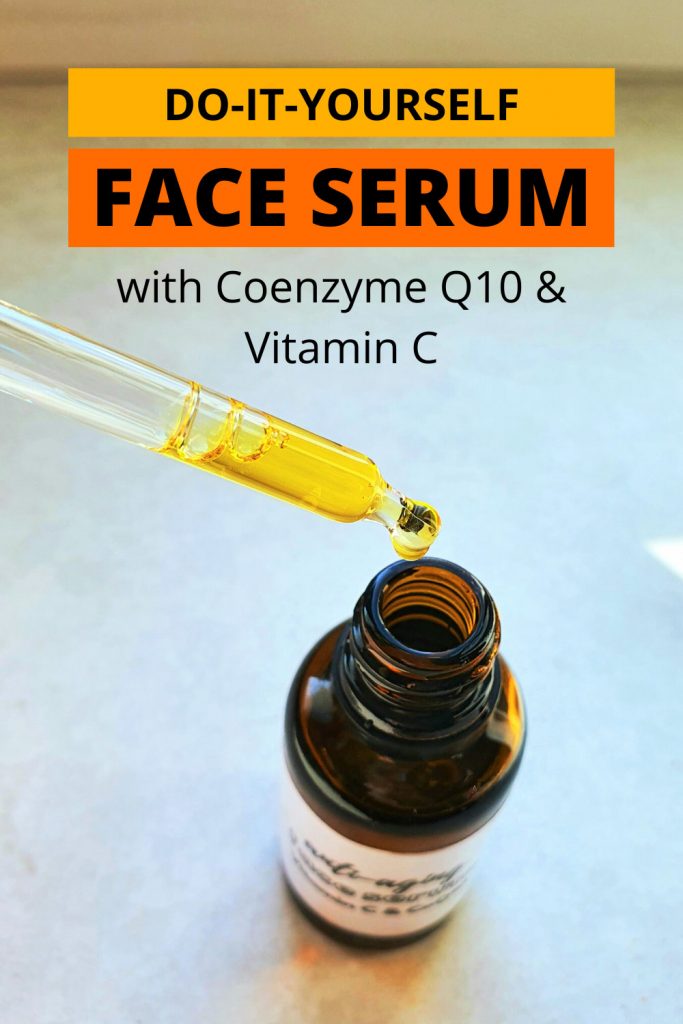Anti-Aging DIY Serum with Vitamin C & CoQ10 [Easy to Make]
This post contains affiliate links. If you click and make a purchase, I may receive a commission. Thanks.
Jump to recipe
Simple to make, DIY anti-aging serum recipe formulated with anti-aging ingredients proven by science.

I would like to start by saying that I am very proud of this recipe. I have a huge interest in anti-aging skincare ingredients, and I am always looking for ways to incorporate these ingredients into my DIY skincare products. When I research my ingredients, I want to make sure that they are not only effective and safe, but also easy to use in homemade products. I have quite a list of such ingredients in my notes, and I promise I will create recipes with all of them at some point.
Today, I will share with you an easy DIY anti-aging serum with ingredients that make me excited the most: Vitamin C and Coenzyme Q10.
These 2 ingredients are some of the most researched anti-aging skincare ingredients out there. Both have been proven to be effective by multiple studies.a
You may ask – Will a DIY newbie be able to use these ingredients? Coenzyme Q10 seem like serious stuff.
Yes, we are making serious stuff! And yes, you will easily be able to replicate this formula!
This recipe is as easy as making a body butter. Like I just mentioned, I have a not-so-small list of effective anti-aging ingredients. However, for this DIY facial serum, I chose only oil-soluble ingredients. No water-based ingredients that might spoil and no preservatives needed. Simple and effective. This recipe is a great example that with some proper research, anyone can make professional strength skincare products that are effective and safe.
I have no doubt that you will like this recipe as much as I do. But before we jump into making this DIY face serum, let me tell you a little bit more about the ingredients.

Ingredients aka why this DIY face serum has anti-aging properties?
What ages us?
One of the biggest culprits of aging skin are free radicals. Free radicals are unstable atoms that can damage our cells. As we age, and as free radicals take their toll on the collagen and elastin in our skin, the skin loses its strength and elasticity.
Unfortunately, free radicals exist naturally within our body as a waste product of our metabolism. However, it is very important to note that their concentrations are highly increased by our lifestyle and environmental factors such as UV radiation, pollution, smoking and poor diet.
To fight these free radicals our bodies use strong antioxidants. One of them is Coenzyme Q10, which can be found in every cell. CoQ10 neutralizes free radicals, reducing their concentrations and minimizing their effect on collagen and elastin in the skin.
An interesting fact is that our natural levels of CoQ10 start to gradually decline at the age of 20 even though our bodies need more and more of it as we age.

The good news is that CoQ10 can be replenished!
Using serums, moisturizers and lotions containing CoQ10 can significantly increase its concentration in the skin. This will help your skin fight free radicals and remain strong and elastic.
Here are some studies talking about CoQ10 anti-aging benefits when applied topically:
Coenzyme Q10, a cutaneous antioxidant and energizer
Mechanisms of inhibitory effects of CoQ10 on UVB‐induced wrinkle formation in vitro and in vivo
Vitamin C
The 2nd star ingredient in this DIY anti-aging serum recipe is vitamin C. Vitamin C is not just an active ingredient. It is a holy grail for many skincare enthusiasts around the world. Not only there are plenty of studies proving its efficacy for anti-aging but also many people online sharing their success stories using vitamin C based products.
I don’t want to make this article too long, so I won’t go into details about vitamin C. For a quick summary, see this quote from one study:
“RESULTS: As one of the most powerful antioxidants in the skin, vitamin C has been shown to protect against photoaging, ultraviolet-induced immunosuppression, and photocarcinogenesis. It also has an antiaging effect by increasing collagen synthesis, stabilizing collagen fibers, and decreasing collagen degradation. It decreases melanin formation, thereby reducing pigmentation. Vitamin C is the primary replenisher of vitamin E and works synergistically with vitamin E in the protection against oxidative damage.”
What Vitamin C to use
Before writing this post I had a look at other homemade anti-aging serum recipes online. Most recipes, as expected, use ascorbic acid, because it is the most well known form of vitamin C.
The problem is that ascorbic acid is highly unstable. It is very effective but can oxidize quickly, loosing all its power. Even skin-care companies struggle with this, so what are the chances that we can make a stable, effective product at home using ascorbic acid? Very low, if you ask me. Some DIY beauty gurus address this issue by remaking the vitamin C serum weekly to ensure it is always fresh and delivers results.
But I have found a better solution – Tetrahexyldecyl Ascorbate.
Tetrahexyldecyl Ascorbate is a more stable and gentler version of vitamin C. It is considered to be slightly weaker than ascorbic acid, but it is way more reliable and does not cause skin irritation (unlike ascorbic acid). Tetrahexyldecyl Ascorbate is resistant to oxidation for up to 18 months. Also, it’s effective at pH levels 5.5-6.5 that are better for our skin.
Tetrahexyldecyl Ascorbate delivers skin benefits at usage rates as low as 0.5%. It is also fully oil-soluble which makes it super easy to work with. You can just add it to your favorite oils and enjoy effective vitamin C skin benefits without irritation.
Here are some study results from Tetrahexyldecyl Ascorbate topical application:
Rosehip oil
As a base for this recipe, I used Rosehip oil. If you have your favorite face oil, feel free to use it in this recipe instead. Jojoba oil is a very good alternative as it suits all skin types.
I chose Rosehip oil because it is one of few carrier oils that can offer effective anti-aging benefits. This is thanks to its high vitamin A content. You see, Vitamin A consists of several nutritional compounds, including retinoids. Retinoids are known for their ability to fade scars, reduce hyperpigmentation and other visible signs of aging when used regularly.
Another reason to choose Rosehip oil, is that it has a pretty good fatty acid profile. It has high levels of linoleic acid (omega 6) and alpha-linolenic acid (omega 3) – the fatty acids that our skin craves the most.
Rosehip oil sinks into the skin pretty fast and does not feel too greasy, so most people enjoy using it on their faces.
Vitamin E oil
Vitamin E oil is a well known antioxidant and anti-aging ingredient. I try to add it to most of my oil-based formulations. Not only does it boosts the antioxidant levels of the product, but also extends shelf life of oils, so we can enjoy our serums for longer.
What results to expect from this facial serum?
Something to note is that aging does not happen overnight, so the results need some time to show as well.
Vitamin C should deliver visible results within a month (depending on your current skin condition). You should see your skin becoming brighter and more evenly toned.
Meanwhile, CoQ10 will help your skin to fight free radicals and maintain its youth long-term. Rosehip oil will provide anti-aging properties (through vitamin A) and will enrich your skin with essential fatty acids that are necessary for the skin to maintain a healthy protective barrier in order to retain moisture.
Pin it for later:

How to use face serum with Vitamin C & CoQ10?
I like to use this face serum at night. I apply it on damp skin immediately after a shower. This way, the oil seals moisture inside the skin and creates a protective barrier.
Of course, you can use it during the day too as Rosehip oil absorbs well. However, don’t forget to apply sunscreen on top as vitamin C can make your skin more sensitive to the sun.
Anti-aging face serum recipe
88.5 % | 26.5 g – Rosehip Seed Oil
10% | 3 g – Vitamin C (Tetrahexyldecyl Ascorbate)
1% | 0.3 g – Q-MAX Coenzyme Q10
0.5% | 0.15 g – Vitamin E
To make this DIY face serum you will also need the following equipment:
– 30 ml bottle with a dropper (comes with a mini funnel)

Making DIY anti-aging serum
The process of making this DIY face serum is very simple because all the ingredients are oil-soluble. Simply measure all your ingredients, combine them in a bottle and shake to mix.
It’s that simple! Despite how easy it is to make, the effectiveness of this DIY serum comes from the powerful ingredients used.
You can add couple drops of essential oils if you’d like some scent. Avoid adding more than couple as it may cause skin irritation.
DIY Anti-aging Face Serum With Vitamin C & CoQ10
This simple face serum recipe is formulated to even out a skin tone and provide anti-aging effects, such as cell regeneration and reduced appearance of wrinkles. You should see your skin becoming brighter and more evenly toned due its vitamin C content. Meanwhile, CoQ10 will help your skin to fight free radicals and maintain its youth long-term. Rosehip oil will provide anti aging properties (through vitamin A) and will enrich your skin with essential fatty acids that are necessary for the skin to maintain a healthy protective barrier.
Ingredients
- 88.5 % | 26.5 g - Rosehip oil
- 10% | 3 g - Vitamin C (Tetrahexyldecyl Ascorbate)
- 1% | 0.3 g - Q-MAX Coenzyme Q10
- 0.5% | 0.15 g - Vitamin E
Instructions
- The process of making this DIY face serum is very simple because all the ingredients are oil-soluble. Simply measure all your ingredients, combine them in a bottle and shake to mix.
- You can add couple drops of essential oils to have some scent. Avoid adding more than couple as it may cause skin irritation.

hi want to ask regarding on this serum, do i need to put any preservatives? if not, how long can this serum be kept?
Hello Melvin, you don’t need to add preservatives because the serum is oil-based. Bacteria will not grow in oil unless water is introduced. The serum will last as long as the shortest shelf life of your ingredients. For example, if your Rosehip seed oil expires in 4 months, vitamin C in 1 year and CoQ10 in 6 months, then your serum is good to use for 4 months (shortest shelf life of your ingredients).
Love this oil serum so much.
The recipe is amazing.
So simple and easy to handle.
Thanks a lot.
Hi thank you sooo much for for this serum. I would like to know about the q10, where can I get it? Do you have other diy products recipes I could try. My skin is very sensitive to chemicals found many commercial products.
Thanks
Yvonne
This anti-aging skincare fac serum is good for health. I would love to try this recipe. This one is the best dialysis center in karachi. They have some of the cool staff always available to people.
This is such an amazing recipe for anti-aging serum. I would definitely try this at home. We have some of the great ideas for skin care in UAE. They are working flawlessly and much helpful for the ladies.
Is it possible to use regular L- asorbic acid? I only ask because I bought a bunch of it and would like to use it up… Thank you for the awesome recipe and for sharing it with us!
L-ascorbic acid is only soluble in water. It won’t dissolve in oil. But tetrahexyldecyl ascorbate dissolves in oil.
Hello. This is a lovely recipe but I would like to know, would 1% Tetrahexyldecyl Ascorbate be effective in a body oil of batch size 5,000grams?
Thank you for the recipe! I bought ascorbic palmitate because I thought that it was oil soluable. Turns out, it is only *sort of* oil soluble. I have been looking everywhere to figure out how to make it soluble (or what to add to do to make it so), but I haven’t found an answer. I wondered whether you might know! Thanks in advance.
Great recipe. But can I use squalan istead of rosehip oil?
Hello n thanku so much for sharing this lovely formulation with us, can we add any essential oils for smell coz I want to add lemon ess. oil in this for fragrance…pls do reply
Storage?
Can I combine it with hyaluronic and seram??
I have a question about how to measure the quantities of ingredients. Since the tetrahexyldecyl Ascorbate and vitamin E come in liquid, not solid, form, how do you obtain the appropriate weights? Also is the vitamin E a mix of tocopherols or just alpha tocopherol? Lastly, I would use ubiquinol and not ubiquinone. See https://www.ncbi.nlm.nih.gov/pmc/articles/PMC4737275/pdf/BIOF-41-383.pdf
As a retired chemist I will experiment with the DIY formula you have proposed. I thank for providing it.